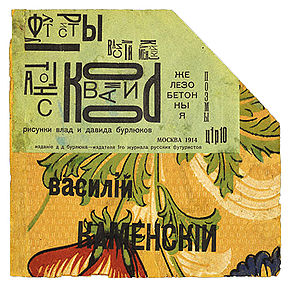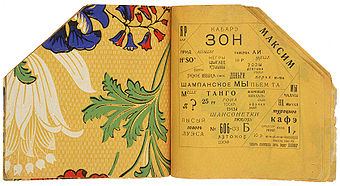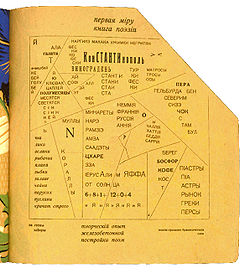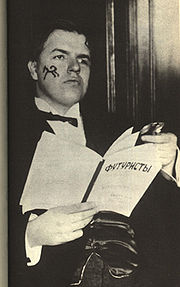
Tango With Cows
Encyclopedia

Vasily Kamensky
Vasily Vasilevich Kamensky was a Russian Futurist poet, playwright, and artist as well as one of the first Russian aviators.Kamensky was born in the Perm district, where his father was an inspector of goldfields...
, with additional illustrations by the brothers David
David Burliuk
David Davidovich Burliuk was a Russian avant-garde artist of Ukrainian origin , book illustrator, publicist, and author associated with Russian Futurism...
and Vladimir Burliuk . Printed in Moscow
Moscow
Moscow is the capital, the most populous city, and the most populous federal subject of Russia. The city is a major political, economic, cultural, scientific, religious, financial, educational, and transportation centre of Russia and the continent...
in 1914 in an edition of 300 , the work has become famous primarily for being made entirely of commercially produced wallpaper, with a series of concrete poems
Concrete poetry
Concrete poetry or shape poetry is poetry in which the typographical arrangement of words is as important in conveying the intended effect as the conventional elements of the poem, such as meaning of words, rhythm, rhyme and so on....
- visual poems that employ unusual typographic layouts for expressive effect - printed onto the recto
Recto
The recto and verso are respectively the "front" and "back" sides of a leaf of paper in a bound item such as a codex, book, broadsheet, or pamphlet. In languages written from left to right the recto is the right-hand page and the verso the left-hand page...
of each page.
Tango with Cows... offers a tour of Moscow's urban entertainment. In his "ferro-concrete" (reinforced concrete) poems, Vasily Kamensky replaced grammar and syntax with a spatial arrangement of words that celebrates concrete as a dynamic force in the invention of the modern city. The artists discarded customary book materials and printed Tango on cheap wallpaper as a parody of urban bourgeois taste. By juxtaposing the urban tango—an erotic Argentine dance that arrived in Russia in 1913 via Paris—with the cows of rural Russia, Kamensky captured the tension poets and artists felt between the recovery of a rural past and the allure of an urban present in creating their art of the future.
Hylaea

Blériot XI
The Blériot XI is the aircraft in which, on 25 July 1909, Louis Blériot made the first flight across the English Channel made in a heavier-than-air aircraft . This achievement is one of the most famous accomplishments of the early years of aviation, and not only won Blériot a lasting place in...
after taking lessons from Louis Blériot
Louis Blériot
Louis Charles Joseph Blériot was a French aviator, inventor and engineer. In 1909 he completed the first flight across a large body of water in a heavier-than-air craft, when he crossed the English Channel. For this achievement, he received a prize of £1,000...
himself, until a crash in 1912 persuaded him to retire;
"Kamensky’s tenure as a pilot was short-lived. The poet’s aerial career met an abrupt end only a few months after he had earned his wings. Following a near-fatal crash into a muddy bog, Kamensky abandoned aviation and returned to literature. Still, the airborne experiences profoundly shaped his artistic vision. In the years to come, Kamensky worked to incorporate the sights, sounds, and sensations of the new technology into his poetry and prose. The result was a series of radically new works that helped shape Cubo-Futurism and, in doing so, contributed to the rise of modern aesthetics."
He became involved in Hylaea, the avant-garde group centred around the brothers David, Nikolay and Vladimir Burliuk at around the same time. Hylaea was the ancient Greek name for the Kherson
Kherson
Kherson is a city in southern Ukraine. It is the administrative center of the Kherson Oblast , and is designated as its own separate raion within the oblast. Kherson is an important port on the Black Sea and Dnieper River, and the home of a major ship-building industry...
region where the Burliuks owned an estate, and the name was intended to evoke a 'poetic suggestion... of a trend in art and literature [to look] back to prehistory in order to build the future. ' Kamensky and Velimir Khlebnikov
Velimir Khlebnikov
Velimir Khlebnikov , pseudonym of Viktor Vladimirovich Khlebnikov , was a central part of the Russian Futurist movement, but his work and influence stretch far beyond it.Khlebnikov belonged to Hylaea,...
joined almost immediately; Vladimir Mayakovsky
Vladimir Mayakovsky
Vladimir Vladimirovich Mayakovsky was a Russian and Soviet poet and playwright, among the foremost representatives of early-20th century Russian Futurism.- Early life :...
and Aleksei Kruchenykh
Aleksei Kruchenykh
Aleksei Eliseevich Kruchenykh or Kruchonykh or Kruchyonykh , a well-known poet of the Russian "Silver Age", was perhaps the most radical poet of Russian Futurism, a movement that included Vladimir Mayakovsky, David Burliuk and others. Together with Velimir Khlebnikov, Kruchenykh is considered the...
shortly after.
All of these men shared a taste for outrage, as well as a prediliction for publishing artists' books; the first product of the group was the scandalous A Slap In The Face of Public Taste 1912, (see http://www.unknown.nu/futurism/slap.html) which featured a number of manifestos and was bound in burlap
Burlap
Hessian , or burlap in the US, is a woven fabric usually made from skin of the jute plant or sisal fibres, or may be combined with other vegetable fibres to make rope, nets, and similar products...
. Tango With Cows would follow two years later, and included 3 drawings by David and Vladimir Burliuk to support Kamensky's poems.
Cubo-Futurism

Cubo-Futurism
Cubo-Futurism was the main school of painting and sculpture practiced by the Russian Futurists.When Aristarkh Lentulov returned from Paris in 1913 and exhibited his works in Moscow, the Russian Futurist painters adopted the forms of Cubism and combined them with the Italian Futurists'...
, originally coined in a lecture by the critic Chukovsky referring to the group's stylistic similarities both to French Cubism
Cubism
Cubism was a 20th century avant-garde art movement, pioneered by Pablo Picasso and Georges Braque, that revolutionized European painting and sculpture, and inspired related movements in music, literature and architecture...
and to the Italian avant-garde
Avant-garde
Avant-garde means "advance guard" or "vanguard". The adjective form is used in English to refer to people or works that are experimental or innovative, particularly with respect to art, culture, and politics....
poet Marinetti's
Filippo Tommaso Marinetti
Filippo Tommaso Emilio Marinetti was an Italian poet and editor, the founder of the Futurist movement, and a fascist ideologue.-Childhood and adolescence:...
new movement (Italian) futurism
Futurism
Futurism was an artistic and social movement that originated in Italy in the early 20th century.Futurism or futurist may refer to:* Afrofuturism, an African-American and African diaspora subculture* Cubo-Futurism* Ego-Futurism...
, with its emphasis on speed and modernity. Adopted by the members of Hylaea - in part to utilise the immense publicity Marinetti was reaping all over Europe - their attitude to Marinetti himself, when he visited St Petersburg
Saint Petersburg
Saint Petersburg is a city and a federal subject of Russia located on the Neva River at the head of the Gulf of Finland on the Baltic Sea...
and Moscow
Moscow
Moscow is the capital, the most populous city, and the most populous federal subject of Russia. The city is a major political, economic, cultural, scientific, religious, financial, educational, and transportation centre of Russia and the continent...
in January 1914, was considerably more ambiguous.
Either by accident or design , Mayakovsky, Burliuk and Kamensky were on a poetry-reading tour of the southern provinces, and so missed Marinetti's visit to Moscow. Moving on to St Petersburg, Livshits
Benedikt Livshits
Benedikt Konstantinovich Livshits /January 6, 1887 — September 21, 1938) was a poet and writer of the Silver Age of Russian Poetry, a French–Russian poetry translator....
and Khlebnikov were awaiting the Italian with a planned boycott of his lecture- avoided at the very last moment .
'The need for fisticuffs became most urgent during an altercation with Livshits at a dinner party. The dispute polarized over their differences regarding the idea of transreason. Marinetti would not budge from his conviction that transrational language was nothing more than the Russian version of his concept of liberated words and wireless imagination while Livshits just as stubbornly claimed that transreason was an altogether different notion, probing deeper into the ontology of the poetic word. In any case, on that evening wild "liberated words" darted back and forth across the table, and soon the literary dispute degenerated into a nationalistic squabble that had little to do with poetry.'
"From this time [1913] Kamensky was an invariable participant in Futurist collections, newspapers, journals, and public appearances." Tango With Cows was his first attempt at publishing futurist verse, and displays clear echoes of Marinetti's contemporary book of concrete poetry, Zang Tumb Tumb
Zang Tumb Tumb
"Zang Tumb Tumb" is a sound poem and concrete poem written by Filippo Tommaso Marinetti, an Italian futurist. It appeared in excerpts in journals between 1912 and 1914, when it was published as an artist's book in Milan. It is an account of the Battle of Adrianople, which he witnessed as a reporter...
.
The book itself

Ferro-concrete poems
Beginning with a drawing by Vladimir Burliuk of a woman, the poems are split into two sections; the first contains 8 concreteConcrete poetry
Concrete poetry or shape poetry is poetry in which the typographical arrangement of words is as important in conveying the intended effect as the conventional elements of the poem, such as meaning of words, rhythm, rhyme and so on....
poems that use multiple fonts and unusual spacings to express sounds and textures. Telephone, for instance, starts with 'Telephone No. 2B_128 / rgrgrrrrrr______rrg'. The second group of 6 are arranged within diagonal grids, that evoke both the cubist paintings of Picasso
Pablo Picasso
Pablo Diego José Francisco de Paula Juan Nepomuceno María de los Remedios Cipriano de la Santísima Trinidad Ruiz y Picasso known as Pablo Ruiz Picasso was a Spanish expatriate painter, sculptor, printmaker, ceramicist, and stage designer, one of the greatest and most influential artists of the...
and Braque
Georges Braque
Georges Braque[p] was a major 20th century French painter and sculptor who, along with Pablo Picasso, developed the art style known as Cubism.-Early Life:...
, and the moulds that are used to make reinforced concrete. These poems refer directly to aerial views, maps and floor-plans.
"The visual construction of the poem 'Shchukin MuseumSergei ShchukinSergei Ivanovich Shchukin was a Russian businessman who became an art collector, mainly of French Impressionist and Post-Impressionist art, following a trip to Paris in 1897, when he bought his first Monet. He later bought numerous works by Paul Cézanne, Vincent van Gogh, and Paul Gauguin, among...
' consisted of a big square divided into several segments, separated by line, with words and names of artists inside of each; one had Matisse, and word associations with his paintings; another Monet with the exclamation "No!" next to it; another Picasso etc. The arrangement exactly follows the display of paintings in the museum, room by room. Kamenskii energetically involves his reader in a dialogue, an interaction, as if inviting him to come along.... [allowing] his reader-companion to wander, to get through the poem and make sense of it in his own way. A Futurist author always avoids closure... enabling his reader-spectator to become a co-author, a co-creator." Nina Gurionova
In Constantinople
Istanbul
Istanbul , historically known as Byzantium and Constantinople , is the largest city of Turkey. Istanbul metropolitan province had 13.26 million people living in it as of December, 2010, which is 18% of Turkey's population and the 3rd largest metropolitan area in Europe after London and...
the poem lists apparently random words (and parts of words) that might be encountered on a trip to the Turkish city; 'Here, one encounters “sailors” (матросы), “mullahs” (муллы), and “seagulls” (чайки). There, one can glimpse the “shores” of the “Bosphorous” (берег — Босфор) and the ancient cathedral “Hagia Sophia” (Ай Софи).' Eschewing a traditional linear development, the poem instead evokes the view from an aeroplane overhead;
"It is only when we recall Kamensky’s experience as an aviator that “Constantinople” makes sense. The visually arresting, unreadable composition is a literal word-map depicting the city’s architectural features, inhabitants, and urban neighborhoods as experienced from overhead while looking down from an airplane. Little-known beyond a small circle of Russian literary and cultural scholars, “Constantinople” is one of the earliest and most important examples of aviation’s vital role in transforming twentieth-century art." Scott W Palmer
Both sets are interspersed with a single drawing by David Burliuk; done in a cubo-futurist style, the first might be of a woman, the second seems to depict an old man.
Tango With Cows (poem)
Life is shorter than the squeal of a sparrow.
Like a dog, regardless, sailing
on an ice floe down the river in spring?
With tinned mirth
we look at our destiny.
We - the discoverers of countries -
conquerors of the air -
kings of orange groves
and cattle.
Perhaps we will drink
a glass of wine
to the health of the comets,
expiring diamond blood.
Or better still – we’ll get a record player.
Well, to hell with you! -
hornless and ironed!
I want one - to dance one
tango with cows
and to build bridges -
from the tears
of bovine jealousy
to the tears
of crimson girls.
Touring the new aesthetic

“From December 1913 to April 1914, the notoriety of the Cubo-Futurists reached its peak as Burliuk, Maiakovsky, and Kamensky toured 17 cities in the Russian Empire. The appearance of the Futurists (they liked to wear gaudy waistcoats, sometimes painted animals on their faces and wore carrots in their lapels) and their ‘performances,’ which included drinking tea on stage under a suspended piano, drew packed audiences, scandalized many, but also won converts to the new art.” Dr. Shkandrij
The spat with Marinetti, intended to unify and strengthen the group, had the opposite effect; the Cubo-futurists were to split under the strain . Khlebnikov was the first to leave, retreating to Astrakhan to work on his dream of a Society of Globe Presidents; Livshits joined the army; Kruchenykh fled the revolution
October Revolution
The October Revolution , also known as the Great October Socialist Revolution , Red October, the October Uprising or the Bolshevik Revolution, was a political revolution and a part of the Russian Revolution of 1917...
to the relative calm of Tiflis
Tbilisi
Tbilisi is the capital and the largest city of Georgia, lying on the banks of the Mt'k'vari River. The name is derived from an early Georgian form T'pilisi and it was officially known as Tiflis until 1936...
; David Burliuk eventually reached the USA .
Kamensky himself welcomed the revolution, and was to play a minor part in Ossip Brik and Mayakovsky's LEF
LEF (journal)
LEF was the journal of the Left Front of the Arts , a widely ranging association of avant-garde writers, photographers, critics and designers in the Soviet Union. It had two runs, one from 1923 to 1925 as LEF, and later from 1927 to 1929 as Novy LEF...
, an artistic organisation aimed at unifying left-wing artists to help build a communist state.
Editions of Tango With Cows and Naked Among The Clad
The book was published in an edition of 300; a sister edition entitled Нагой среди Одетьіх (Naked Among The Clad) by Kamensky with Andrei Kravtsov was also published in an edition of 300 the same year; it too featured ferro-concrete poems - including some that also featured in Tango - and was again printed onto cheap wallpaper.Copies of Tango With Cows are held in a number of prestigious public collections, including MOMA
Moma
Moma may refer to:* Moma , an owlet moth genus* Moma Airport, a Russian public airport* Moma District, Nampula, Mozambique* Moma River, a right tributary of the Indigirka River* Google Moma, the Google corporate intranet...
, the Getty Center
Getty Center
The Getty Center, in Brentwood, Los Angeles, California, is a campus for cultural institutions founded by oilman J. Paul Getty. The $1.3 billion center, which opened on December 16, 1997, is also well known for its architecture, gardens, and views overlooking Los Angeles...
and the British Library
British Library
The British Library is the national library of the United Kingdom, and is the world's largest library in terms of total number of items. The library is a major research library, holding over 150 million items from every country in the world, in virtually all known languages and in many formats,...
.
See also
- Russian FuturismRussian FuturismRussian Futurism is the term used to denote a group of Russian poets and artists who adopted the principles of Filippo Marinetti's "Manifesto of Futurism"...
- BÏF§ZF+18BÏF§ZF+18BÏF§ZF+18 Simultaneità e Chimismi lirici is a poetry book and artist's book published in 1915 by the Italian futurist Ardengo Soffici...
, an artist's book by the Italian futurist Ardengo Soffici. - The cubo-futurist poet Vladimir MayakovskyVladimir MayakovskyVladimir Vladimirovich Mayakovsky was a Russian and Soviet poet and playwright, among the foremost representatives of early-20th century Russian Futurism.- Early life :...
.
External links
- A pdf of the entire book
- A copy in a Russian collection bound in a slightly different order
- MOMA's copy online
- MOMA's copy of Tango's sister publication, Naked Among The Clad, also 1914.
- A Slap in the Face of Public Taste.
- A translation of Telephone by Eduardo Kac, one of the concrete poems in Tango With Cows.

